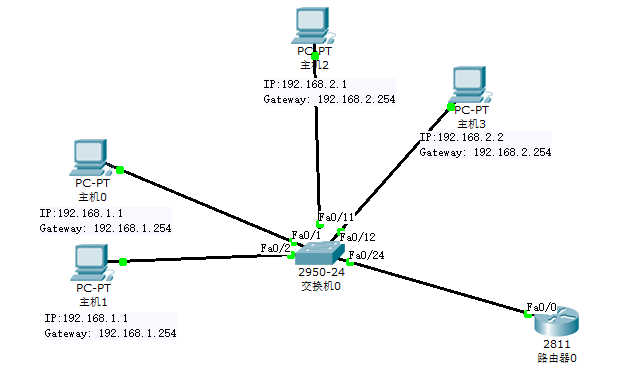单臂路由(router-on-a-stick)是指在路由器的一个接口上通过配置子接口(或“逻辑接口”,并不存在真正物理接口)的方式,实现原来相互隔离的不同VLAN(虚拟局域网)之间的互联互通。
环境
PC0和PC1与交换机fa0/1、fa0/2 接口连接,划分在VLAN10中,IP分别为192.168.10.1、192.168.10.2,网关192.168.10.254。
PC2和PC3与交换机fa0/11、fa0/12 接口连接,划分在VLAN20中,IP分别为192.168.20.1、192.168.20.2,网关192.168.20.254。
交换机fa0/24端口与路由器fa0/1端口连接。
(2)配置交换机
/* Part 1 配置交换机 */Switch>enableSwitch#configure terminalSwitch(config)#hostname SASA(config)#vlan 10SA(config-vlan)#vlan 20SA(config-vlan)#exitSA(config)#interface range fa0/1-fa0/2SA(config-if-range)#switchport access vlan 10SA(config-if-range)#interface range fa0/11-fa0/12SA(config-if-range)#switchport access vlan 20SA(config-if-range)#interface fa0/24SA(config-if)#switchport mode trunkSA(config-if)#switchport trunk allowed vlan all/* Part 2 检查配置 */SA(config-if-range)#^Z (Ctrl+Z组合键)SA#show vlan...VLAN Name Status Ports---- -------------------------------- --------- -------------------------------1 default active Fa0/3, Fa0/4, Fa0/5, Fa0/6Fa0/7, Fa0/8, Fa0/9, Fa0/10Fa0/13, Fa0/14, Fa0/15, Fa0/16Fa0/17, Fa0/18, Fa0/19, Fa0/20Fa0/21, Fa0/22, Fa0/2310 VLAN0010 active Fa0/1, Fa0/220 VLAN0020 active Fa0/11, Fa0/12...
(3)配置路由器
/* Part 1 配置路由器 */Router>enableRouter#configure terminalRouter(config)#hostname RARA(config)#interface fa0/0.1RA(config-subif)#encapsulation dot1Q 10// (1:在路由器上配置trunk的封装协议的命令:// encapsulation [isl/dot1q] vlan#// 2:上面的路由器配置了dot1q中继封装,10是vlan 10。// 3:Trunk的封装类型一共有 ISL和802.1Q两种,而802.1Q在输入的时候为dot1q)RA(config-subif)#ip address 192.168.10.254 255.255.255.0RA(config-subif)#interface fa0/0.2RA(config-subif)#encapsulation dot1Q 20RA(config-subif)#ip address 192.168.20.254 255.255.255.0RA(config-subif)#exitRA(config)#interface fa0/0RA(config-if)#shutdownRA(config-if)#no shutdown //(重启fa0/0接口)/* Part 2 检查配置 */RA>show interfaces fa0/0.1...Internet address is 192.168.1.254/24...Encapsulation 802.1Q Virtual LAN, Vlan ID 10...RA>show interfaces fa0/0.2...Internet address is 192.168.2.254/24...Encapsulation 802.1Q Virtual LAN, Vlan ID 20...
(4)连通性测试
/* Part 1 PC0 Ping 自己网关 */PC>ping 192.168.1.254Pinging 192.168.1.254 with 32 bytes of data:Reply from 192.168.1.254: bytes=32 time=11ms TTL=255Reply from 192.168.1.254: bytes=32 time=12ms TTL=255Reply from 192.168.1.254: bytes=32 time=11ms TTL=255Reply from 192.168.1.254: bytes=32 time=12ms TTL=255Ping statistics for 192.168.1.254:Packets: Sent = 4, Received = 4, Lost = 0 (0% loss),Approximate round trip times in milli-seconds:Minimum = 11ms, Maximum = 12ms, Average = 11ms/* Part 2 PC0 Ping PC1 */PC>ping 192.168.1.2Pinging 192.168.1.2 with 32 bytes of data:Reply from 192.168.1.2: bytes=32 time=25ms TTL=128Reply from 192.168.1.2: bytes=32 time=10ms TTL=128Reply from 192.168.1.2: bytes=32 time=12ms TTL=128Reply from 192.168.1.2: bytes=32 time=14ms TTL=128Ping statistics for 192.168.1.2:Packets: Sent = 4, Received = 4, Lost = 0 (0% loss),Approximate round trip times in milli-seconds:Minimum = 10ms, Maximum = 25ms, Average = 15ms/* Part 3 PC0 Ping PC2 PC3网关 */PC>ping 192.168.2.254Pinging 192.168.2.254 with 32 bytes of data:Reply from 192.168.2.254: bytes=32 time=11ms TTL=255Reply from 192.168.2.254: bytes=32 time=14ms TTL=255Reply from 192.168.2.254: bytes=32 time=11ms TTL=255Reply from 192.168.2.254: bytes=32 time=12ms TTL=255Ping statistics for 192.168.2.254:Packets: Sent = 4, Received = 4, Lost = 0 (0% loss),Approximate round trip times in milli-seconds:Minimum = 11ms, Maximum = 14ms, Average = 12ms/* Part 4 PC0 Ping PC2 */PC>ping 192.168.2.1Pinging 192.168.2.1 with 32 bytes of data:Reply from 192.168.2.1: bytes=32 time=24ms TTL=127Reply from 192.168.2.1: bytes=32 time=19ms TTL=127Reply from 192.168.2.1: bytes=32 time=21ms TTL=127Reply from 192.168.2.1: bytes=32 time=20ms TTL=127Ping statistics for 192.168.2.1:Packets: Sent = 4, Received = 4, Lost = 0 (0% loss),Approximate round trip times in milli-seconds:Minimum = 19ms, Maximum = 24ms, Average = 21ms/* Part 5 PC0 Ping PC3 */PC>ping 192.168.2.2Pinging 192.168.2.2 with 32 bytes of data:Request timed out.Reply from 192.168.2.2: bytes=32 time=24ms TTL=127Reply from 192.168.2.2: bytes=32 time=22ms TTL=127Reply from 192.168.2.2: bytes=32 time=19ms TTL=127Ping statistics for 192.168.2.2:Packets: Sent = 4, Received = 3, Lost = 1 (25% loss),Approximate round trip times in milli-seconds:Minimum = 19ms, Maximum = 24ms, Average = 21ms
结论
由实验可知,划分VLAN后不同VLAN间的主机不能通信,可以使用路由器进行VLAN间通信。
注意: 1、主机需要配网关。 2、当出现Ping不通别的主机时,可以采用由近及远的检查方式,即依次Ping自己、自己的网关、对方主机的网关、对方主机以便于发现错误位置。


